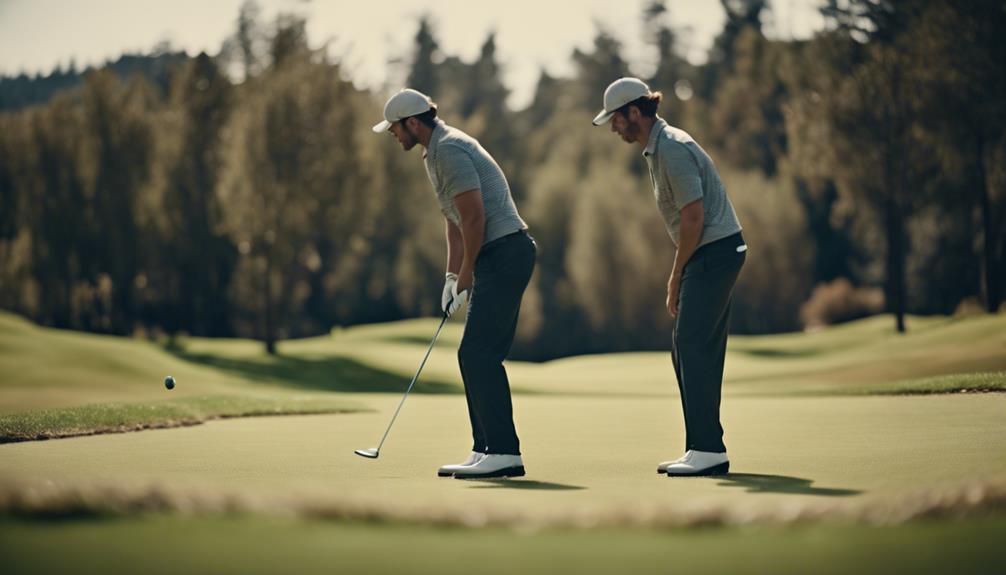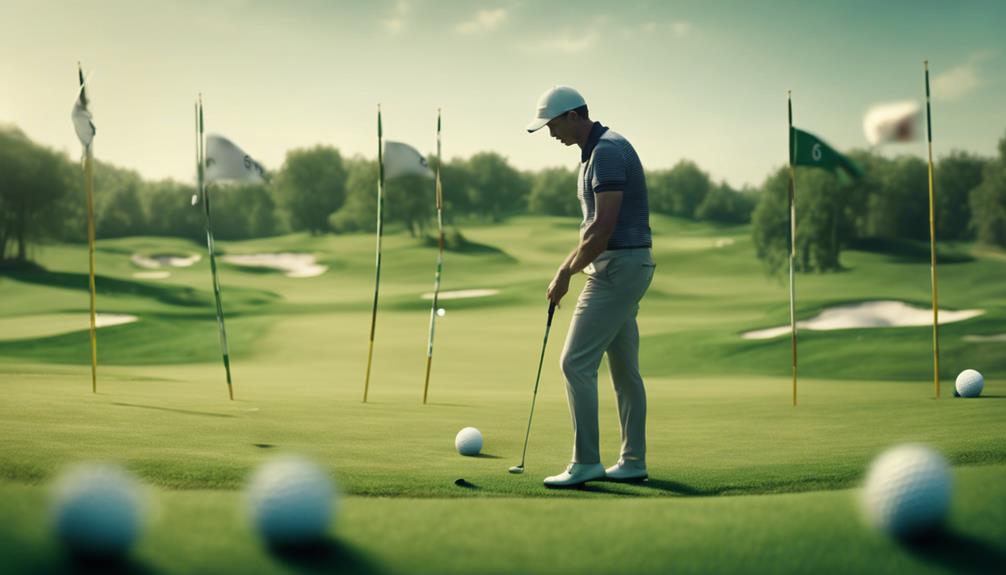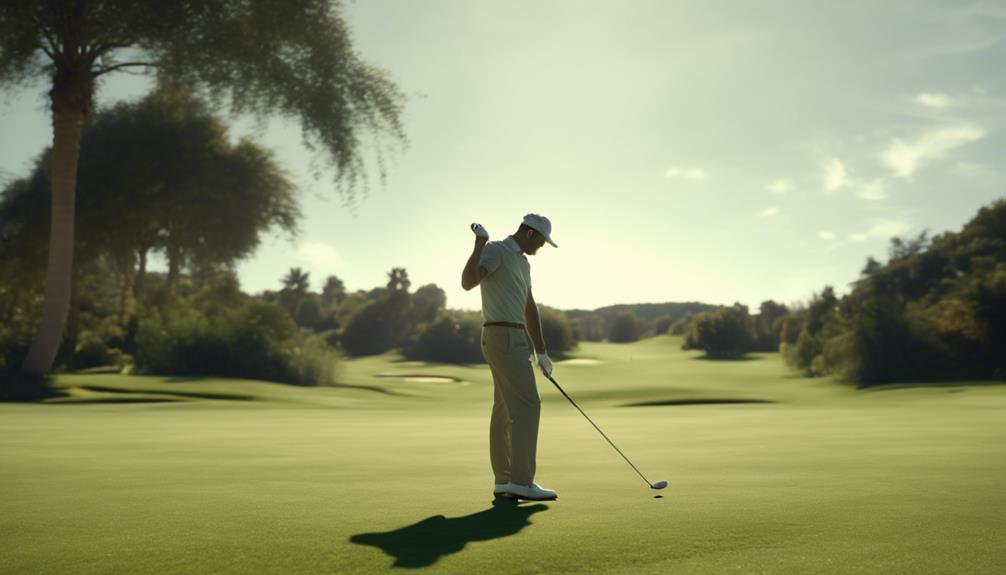- 7 Top Flite Golf Clubs XL for Improved Performance - September 28, 2024
- Top Flite Golf Clubs: Top 5 Reasons to Choose Them - September 28, 2024
- Top 3 Golf Club Fitters for a Perfect Swing - September 28, 2024
You can shallow the golf club with a consistent and powerful swing by mastering a few key adjustments to your backswing and downswing technique. Start by focusing on a balanced plane, keeping your club and hands aligned, and ensuring they're on the same plane. Then, practice moving your club head beyond your hands and extending your backswing for space. Next, focus on dropping your club head below the swing plane to achieve a shallower angle of attack. With these adjustments, you'll be on your way to a more efficient and powerful swing. Now, take it to the next level by refining your technique…
Key Takeaways
- Maintain a full backswing to access golf swing potential and generate power and efficiency for a shallower downswing.
- Position the clubhead outside your hands to ensure a powerful and consistent swing, promoting a wide swing arc and steady swing plane.
- Practice the downswing fall, feeling the club head drop below the swing plane and achieving a shallower angle of attack with a smooth shift.
- Utilize quick drills and techniques, such as mastering the downswing drop motion, to refine club head positioning and focus on efficient swing path adjustment.
- Analyze and refine your swing, using tools like Live View Golf for real-time feedback, to identify areas for improvement and ingrain proper movement patterns.
Master the Backswing Position
To master the backswing position, focus on maintaining a balanced plane by keeping the club and hands aligned during the takeaway. This sets the stage for a consistent and powerful swing. You'll want to ensure the golf club and your hands are on the same plane, allowing for a smooth shift into the rest of your swing. This might require a little bit of practice to get the feel for it, but trust us, it's worth it.
Proper backswing positioning is essential for a solid foundation, and it will greatly influence the path and angle of the club head in the downswing. By maintaining a balanced plane, you'll be able to achieve a full backswing, which is crucial for ideal club positioning at the top.
Get the Club Head Outside
Now that you've mastered the backswing position, it's time to focus on getting the club head outside.
To do this, you'll want to prioritize an early club head exit, allowing your hands to lead the club face and creating an outside path that sets you up for a shallower swing.
Early Club Head Exit
By the top of your backswing, you should be focusing on getting the club head to move beyond your hands, setting the stage for a shallow downswing. This early club head exit is pivotal for achieving a smooth shift and consistent ball striking.
As you extend your backswing, make sure the club head moves outside your hands, creating space for the downswing and encouraging a shallower angle of attack. This will contribute to a more effective swing, allowing you to generate more power without sacrificing control.
Practicing the correct club head path in the backswing can lead to improved swing mechanics and better overall performance. An early release of the club head will also help you achieve a more uniform impact, resulting in more reliable shots.
Hands Lead Club Face
As you swing back, focus on letting your hands lead the club face, keeping them close to your body, which will naturally position the club head outside your hands. This hand positioning is vital for swing efficiency, as it sets up a shallower downswing and promotes better ball striking.
By maintaining control over the club face, you'll achieve more consistent impact and a more reliable swing.
A proper wrist hinge and shoulder turn will help you get the club head in the correct position early in the swing. This will generate power and create space for a successful downswing.
Outside Path Creation
Creating an outside path in your backswing requires you to focus on moving the club head away from your body, establishing an essential angle that sets the stage for a shallower downswing. This pivotal step allows you to reap the benefits of an outside path, including increased swing efficiency and a more powerful downswing.
| Outside Path Benefits | Shallowing Techniques |
|---|---|
| Improved swing efficiency | Reduced steep angles |
| Increased downswing power | More consistent ball contact |
| Enhanced club head control | Better overall swing consistency |
| Reduced slicing and hooking | More accurate shots |
| Simplified swing mechanics | Improved overall game |
To achieve an outside path, focus on getting the club head to move away from your body early in the swing. This will help you establish a more consistent club head position, leading to a more reliable and effective swing. By incorporating this technique into your swing, you'll be able to shallow the club more easily, resulting in more consistent and powerful shots. Remember, practice is key, so be sure to incorporate drills that emphasize getting the club head on the correct path for a more consistent and effective swing.
Maintain a Full Backswing

As you work on maintaining a full backswing, you'll realize its importance in setting up a powerful and consistent swing.
You'll want to focus on best club positioning, making sure it reaches parallel to the ground at the top of the backswing, and maintaining a neutral plane throughout.
Full Backswing Importance
Maintaining a complete backswing is fundamental to accessing your golf swing's potential, as it sets the stage for a powerful and controlled downswing. By finishing your backswing, you'll generate more power and efficiency, allowing you to hit the ball with more consistency and accuracy.
A full backswing also helps you develop a consistent swing arc, which is vital for shallow shots. When you neglect to complete your backswing, you'll likely struggle with swing faults and inconsistency in ball striking. Your downswing will suffer, and you'll lose control over the clubhead speed and direction.
On the other hand, a full backswing allows you to rotate and extend properly, setting the club on the correct path for a shallow downswing. This, in turn, enables you to strike the ball with precision and control.
Optimal Club Positioning
To maintain a shallow angle of attack, focus on positioning the clubhead outside your hands in the backswing, allowing it to fall under on the downswing. This ideal club positioning is essential for a powerful and consistent swing. By getting the clubhead behind your hands, you'll ensure a shallower downswing path, resulting in better club face control and a more uniform ball strike.
A full backswing sets the stage for a smooth weight transfer from back to front, allowing you to generate power and speed.
As you swing back, focus on maintaining a wide swing arc, keeping the clubhead on the correct path. This will help you develop a steady swing plane, making it easier to shallow the club on the downswing.
Maintaining Neutral Plane
You set the foundation for a shallow angle of attack by ensuring the club and hands move on the same plane during the backswing, achieving a neutral position. This allows for prime club positioning, setting the stage for a shallower downswing.
By maintaining a neutral plane, you promote consistency and accuracy in ball striking. To achieve this, focus on swing plane visualization, ensuring your body rotation and shoulder turn are in sync. As you rotate, allow for a natural wrist hinge timing, keeping the club on the proper path.
A well-executed backswing sets the stage for a desirable club path in the downswing, resulting in improved contact. By maintaining a neutral plane, you'll be better positioned to shallow the club, leading to more consistent and accurate shots.
Practice the Downswing Fall
As you shift your focus to the downswing, intentionally feel the club head fall behind your hands, allowing it to drop below the swing plane and shallow out. This is vital for achieving a shallower angle of attack.
Practice downswing sequencing by initiating the downswing with a smooth shift movement, guaranteeing proper timing and allowing the club head to drop into the slot.
Focus on the club head drop, sensing it fall below the swing plane, which will help you maintain a consistent swing path.
To reinforce this motion, practice drills that promote the sensation of the club head dropping into the slot on the downswing. Use video feedback to confirm the club head is properly falling below on the downswing.
Utilize Quick Drills and Techniques

Mastering the downswing drop motion sets the stage for incorporating quick drills and techniques to further shallow the club in your swing. Now, it's time to optimize your backswing and refine your club head positioning.
To do this, focus on getting the club head outside your hands early in the backswing. This will set you up for a more efficient swing path adjustment. Efficient drills, such as practicing with a slower backswing tempo, can help you achieve this.
Additionally, quick techniques like focusing on the club head's position in relation to your hands can make a significant difference. Effective exercises, like rehearsing the backswing with a mirror or video recording, can also help you identify areas for improvement.
Seek Expert Advice and Feedback
Seeking expert advice and feedback from a qualified golf instructor can provide a fresh perspective on your swing mechanics, helping to identify and refine areas where club shallowing techniques can be improved.
You can record your swing and share it with an expert for personalized feedback, or utilize virtual coaching sessions and video swing reviews to get pro feedback. Online lesson forums are also a great resource to get expert tips from experienced golfers and instructors.
By leveraging technology like Live View Golf, you can receive real-time feedback on your swing and make adjustments on the fly. Regularly seeking feedback and guidance from professionals will help you track your progress and make continuous improvements in club shallowing.
Don't be afraid to ask for help – expert advice can help you overcome plateaus and take your game to the next level. By combining expert feedback with your own practice and dedication, you'll be well on your way to mastering the art of club shallowing.
Analyze and Refine Your Swing

With expert feedback in hand, you can now begin to dissect your swing, identifying areas where refinements can be made to achieve a shallower angle of attack. Through swing analysis, you'll pinpoint specific aspects of your technique that require improvement, such as club position and hand placement.
Focus on making adjustments that promote a shallower downswing, like getting the club head outside your hands in the backswing.
Utilize tools like Live View Golf to receive real-time feedback on your swing adjustments, allowing you to fine-tune your technique with precision.
Practice drills that emphasize shallowing the club will help ingrain the proper movement pattern, and expert coaching will provide personalized feedback to guide your improvement.
By combining these techniques, you'll develop a more effective swing that yields consistent results.
Frequently Asked Questions
How to Easily Shallow the Golf Club?
To easily shallow the golf club, you'll focus on positioning the club head outside your hands in the backswing, then practice downswing mechanics drills to develop a shallower angle of attack, optimizing your golf club position.
What Does It Mean to Shallow the Golf Club?
When you shallow the golf club, you're adjusting your downswing mechanics to approach the ball from the inside, reaching an ideal impact position by making subtle swing plane adjustments, resulting in a more powerful strike.
How to Shallow Your Golf Swing a 3 Step Guide for Better Feels?
Imagine a pendulum swinging smoothly, that's the rhythm you're aiming for. To shallow your golf swing, focus on adjusting your swing mechanics to produce a more vertical club path, ensuring a precise impact position for a consistent strike.
How Do I Shallow Out My Driver's Swing?
You'll shallow out your driver's swing by focusing on proper driver alignment, weight transfer, and maintaining a consistent swing speed, while adjusting your backswing angle to optimize club angle and impact position.
Conclusion
As you stand on the green, club in hand, it's no coincidence that your improved backswing and downswing fall have led to a more consistent game. By following these 7 easy steps, you've mastered the art of shallowing the club, and it's paid off.
Your practice and dedication have resulted in a smoother, more controlled swing, and your scores are reflecting it. It's no accident that your hard work has led to success – it's a direct result of your commitment to refining your technique.




